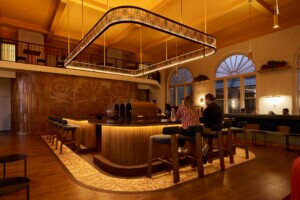The COVID-19-era design typology with the most transformative effect on New York City may be the materially humblest. Comprising little more than coarse plywood, plexiglass, and corrugated board, the jugaad structures sheltering the city’s diners may hold the key to changes in public space that urbanists have long advocated—provided New York makes it through the winter.
Outdoor dining, say architects and others involved with the city’s Open Restaurants program, has been a lifeline to a beleaguered industry and a joy-starved, Zoom-fatigued citizenry. Launched in June after the nonessential-business pause in the spring had limited restaurants to pickups and deliveries, the program was declared permanent by Mayor De Blasio in late September. Sidewalk tents and parking-space pavilions have sprouted up throughout the city, a silver lining amid 2020’s many clouds. Much depends, however, on whether outdoor restaurants and bars can adapt to cold weather, since experts see indoor operations, even at the permitted 25 percent capacity, as risky. Anything higher than that would trigger disaster scenarios, where too many people gathering too closely indoors returns the city’s case count to March levels. At the time of writing, Governor Cuomo has announced a restriction model that would again ban indoor dining in regions where hospitalization rates do not stabilize, making a citywide ban possible by mid-December.
The economy and culture of New York as we know it are inconceivable without restaurants, of which the city had 23,650 in 2019 according to the state Comptroller’s office. The pre-pandemic hospitality sector accounted for 1-in-12 private-sector jobs citywide. Yet a massive hemorrhage of restaurant jobs (dropping from 315,000 to 91,000 between February and April), plus over 1,000 permanent closings to date according to running counts kept by Eater NY and DoNYC, indicate an existential threat to the sector. Temporary and intermittent closings are harder to track but anecdotally widespread. A Hospitality Alliance study released in September found that nearly nine of 10 dining establishments had not paid full August rent, and a third had paid none.
“It is truly a terrifying moment for the city,” said Rockwell Group founder and president David Rockwell, “because as the weather gets cooler and colder, and as the pandemic seems to not be getting better, it’s going to put enormous pressure on an industry that was already stretched very thin. The reality is, if you look at the restaurant industry pre-pandemic, profit margins were very small for many of these restaurants. The landlords were really in control; they weren’t sharing the risk. There were empty storefronts all over the city.”
An empty theater
When COVID dampened public life last March, Rockwell recalled, New York appeared “very much like an empty theater.” As a longtime explorer of the relations between theater and architecture, he imagined design and operational responses using modular, portable, deployable structures that drew on theatrical setups and “the touring rock-and-roll world,” where load-in logistics must be fast and precise. Fielding inquiries from restaurant clients, he joined forces with Melba Wilson, proprietor of Melba’s on W. 114th Street, and Hospitality Alliance executive director Andrew Rigie to develop a pro bono intervention, DineOut NYC, offering a toolkit of safety guideline–compliant prototypes that restaurateurs could adapt on their own.
Pilot projects appeared at Melba’s in Harlem; Ceetay and Hudson Smokehouse in the Bronx; Negril BK in Brooklyn; Pa-Nash in Queens; and The Craft House and Kills Boro Brewing Company on Staten Island. After the first six, the city’s Department of Transportation (DOT) got in touch about safety guidelines and streamlined the process for outdoor-café permits, even allowing self-certification. The Chinatown Business Improvement District (BID) worked with DineOut to create a carfree multi-restaurant seating area on Manhattan’s Mott Street. In July, DineOut became a Partner Program of the Fund for the City of New York, a 501(c)3, to raise funds and help neighborhoods disproportionately affected by COVID-19, including Chinatown, the South Bronx, Elmhurst, and Jackson Heights.
“In New York, for any one idea, there’s at least eight people who think it’s a terrible idea,” Rockwell said. “It is the city of conflicts, and it’s a city of people compressed.”
Yet DineOut has attracted energetic public/private engagement from local businesses, community arts groups, and city officials, plus installation work by “an out-of-work scenic shop, as every scenic shop was, during downtime.” Douglas Mass of Cosentini Associates has contributed engineering expertise, and Pershing Square Capital Management has provided funding for heating equipment at the Mott Street and Dyckman Street communal dining areas—the sine qua non for these and similar spaces to survive the coming months.
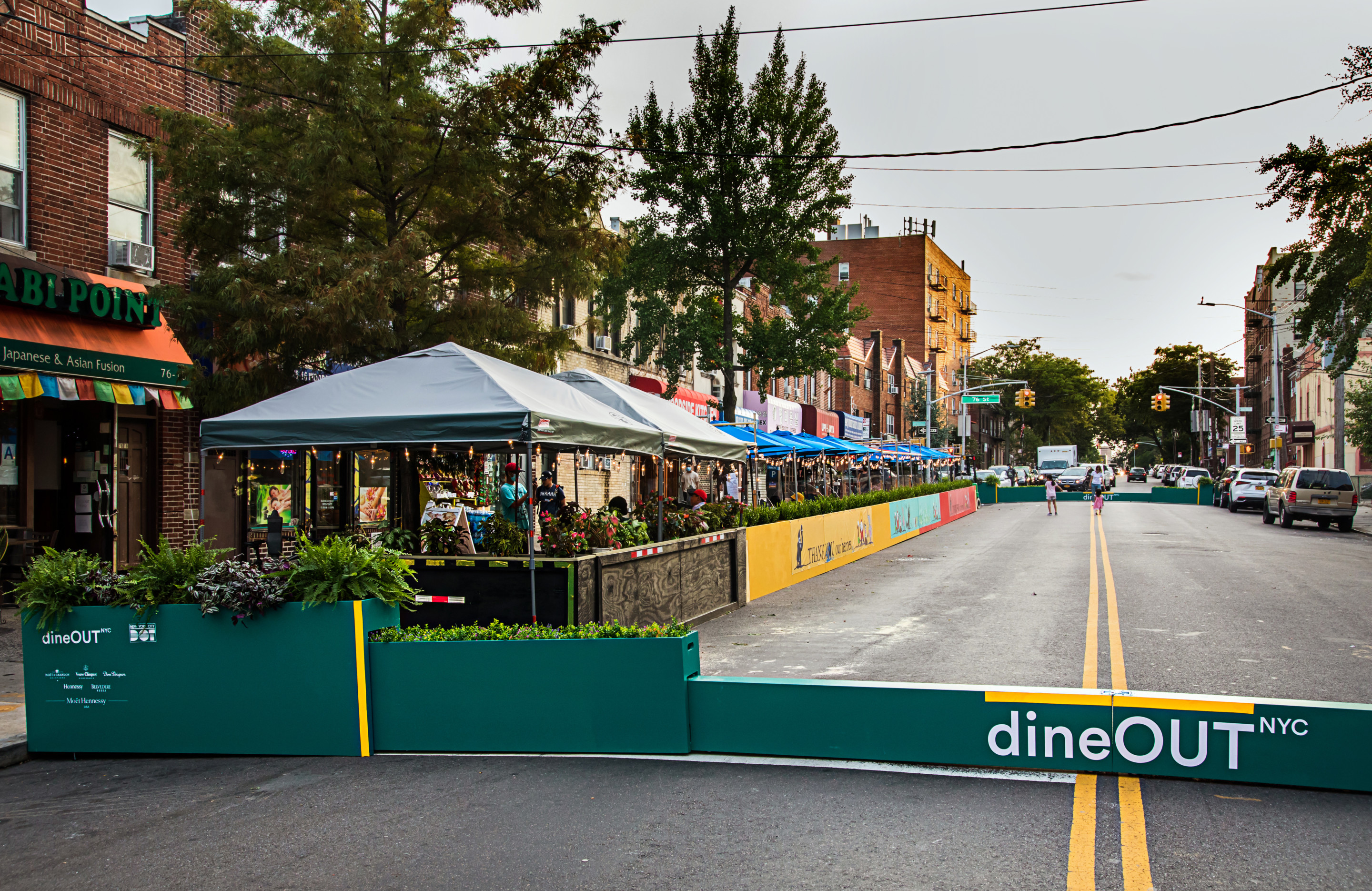
DineOut’s open-source documents address essential details: Host stands and other choke points, ventilation, heating, signage, and telescoping planters. Work is in progress, Rockwell said, on freestanding ballasted windscreens and power-supply structures for heaters (both propane and electric heaters are in use; the latter avoids tank-storage complications). The team continues to study details adapted from different contexts (heated tables from Japan, HEPA filters from medical facilities) and ways the structures can serve purposes beyond dining. Two Bronx BIDs, Rockwell reported, are using the installations as classrooms and performance space.
At the time of writing, the city’s beta-phase Open Restaurants map lists 10,798 establishments certified for outdoor dining. Alongside the Open Streets program, which has removed vehicles from 100 miles of streets to promote social distancing, Open Restaurants and DineOut have catalyzed a rethinking of the public right-of-way. “What made outdoor dining this hopeful moment for the city,” Rockwell summarized, “was, it was almost like the city was turned inside out. We got the activity that had been happening inside restaurants out on the street, in many cases in one of the parking lanes, not disadvantaging bicycles or buses, but thinking about the city less for cars and more for pedestrians… I think that it will trigger thinking about nimbleness; it’ll trigger thinking about collaboration, public and private; it focuses on how to improve public life.”
Ad hoc woonerven
The moment to turn crisis into opportunity may be at hand, but the challenge of serving neighborhoods and enterprises equitably is no easy feat. David Vega-Barachowitz of WXY Architects, which has co-authored its own design “playbook” with Uber Eats for repurposing outdoor spaces, pointed out that minority-owned businesses have been especially hard-hit; by his personal estimate, nearly 40 percent have closed, compared with 25 percent of all establishments. A different form of inequality is that appropriate sites for adaptation are unevenly distributed, he noted: “If you have a restaurant that has a 10-foot frontage and basically no seating inside, and you have a bus stop in front, that puts you in a really difficult position.” Moreover, many struggling restaurants “hardly have the capital to put out for heaters and seating and new structures, especially as they’re trying to comply with an ever-changing set of regulations. This is definitely not just the restaurants’ problem; this is a city issue.”
Saluting DOT for updating its guidelines to include retailers as well as restaurants, Vega-Barachowitz pointed to BIDs that have responded to the city’s Open Restaurants, Open Streets, and Open Storefronts programs with “networks of pedestrianized spaces, akin to what you see all over the place in Europe, where streets are an extension of the businesses. We’ve seen that in the Lower East Side around Orchard Street [and] Ludlow Street, a little bit in Chinatown, and in some particular quarters like Dyckman Street.” WXY has also designed a new dining/retail complex soon to open in Harlem, Renaissance Pavilion at Strivers’ Row, incorporating parklets by Body Lawson Associates, including one on an “ice” theme featuring polyethylene roof panels.
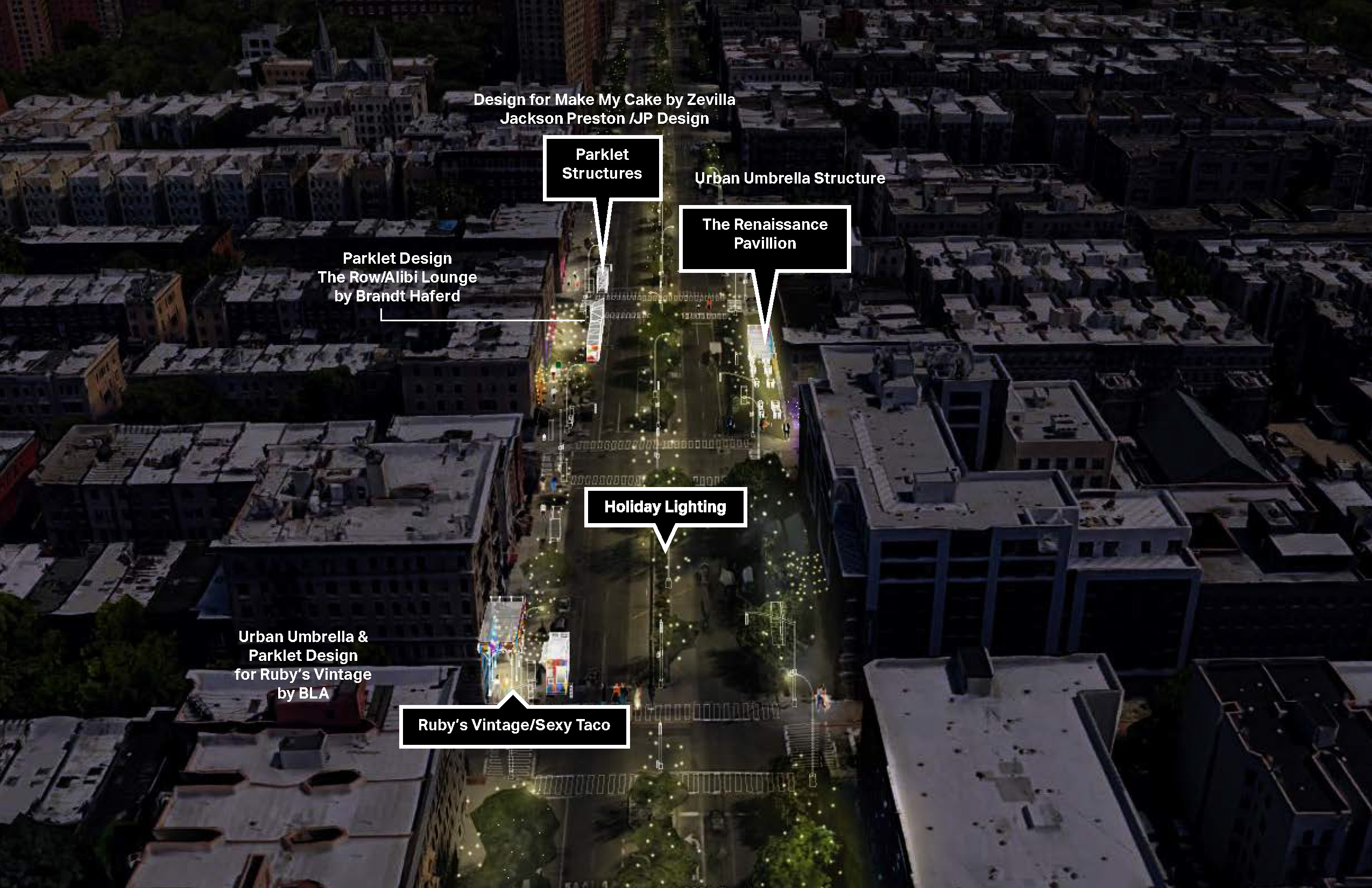
These neighborhoods are coming to resemble Dutch woonerven, the pedestrians-first street model favored by green urbanists, grounding today’s adaptations in a broader history of urban placemaking. Vega-Barachowitz said he had spent a lot of time in the Netherlands “studying their whole way of thinking about street design,” a marked contrast to “the whole legacy of pedestrian malls and why they failed in some ways in the United States.” Observing the latter tendency, he said that experiments with shopping corridors in Lindsay-era New York, Evansville, Ind., Kalamazoo, Mich., and other American cities lacked two key elements: “acceptance of a level of ambiguity in how traffic operates” among traffic engineers and political support for parking reductions. Now, as the Open Streets/Restaurants/Storefronts efforts build on recent programs like the Summer Streets and Weekend Walks, he finds that “public opinion is shifting away from the days when it was unacceptable to remove parking spaces.” New York City, Vega-Barachowitz added, “didn’t have overnight street parking until the 1950s. For a long time, it wasn’t assumed that you could leave your car parked overnight on a New York City street. This is something that was introduced.”
Precedents such as San Francisco’s parklets experiment suggest that an initially transient project can become permanent, incorporating features such as micro-transit and greenhouses. “If you look at San Francisco and Montréal, these are places that have robust parklet programs with high-quality materials, planter boxes that are really meant to be there, and are able to be a bit more weathered over time, rather than being thrown up with the intent of only being around for three or four months.” The Parisian vision of a 15-minute walkable city and the Milanese approach to greenways and plazas, he suggested, are useful long-range models. “My hope is that this groundswell of interest in support for restaurants also translates into an energy and activism to create more greenery on sidewalk extensions, to think about expanding programs that have more [than just] bike parking. There are a lot of competing uses for the curb.”
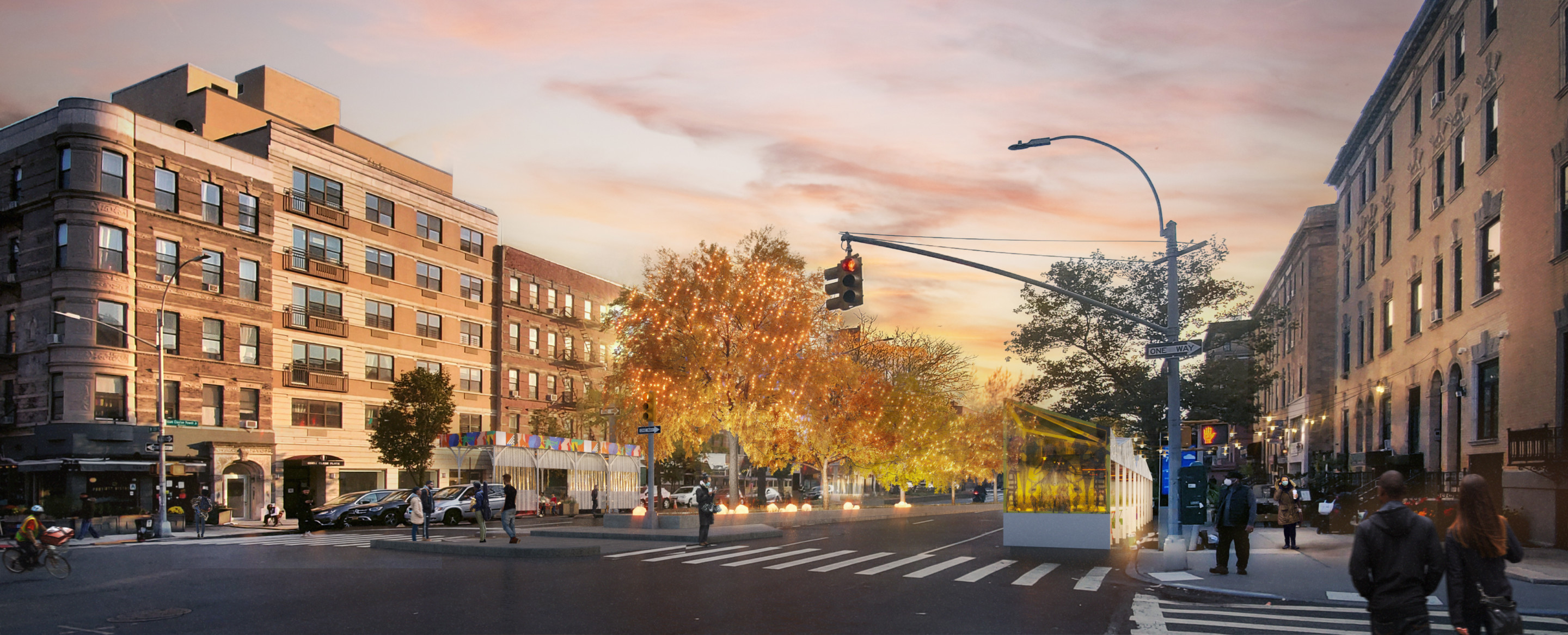
A photograph from Cincinnati’s City Beat that went viral via Twitter last June, Vega-Barachowitz noted, placed two of those uses in alarming contrast: masked participants in a Black Lives Matter protest passing, and being ignored by, a group of maskless yuppies at brunch. Street design and regulation can serve diverse purposes, he emphasized, and in this image “there was a sense that the health of restaurants went beyond the larger concerns and needs of communities, and especially communities of color.” Rethinking public space reveals priorities and hidden biases, making it essential to keep “a much larger vision for cities“ in mind, a vision that keeps public health as the central purpose for moving dining or any other activity outdoors.
Air can hurt you too
The risk that convenience may outweigh health becomes graver as weather drives diners indoors. A set of safety guidelines produced by two of DineOut’s partner organizations, the Aspen Institute and the James Beard Foundation, includes detailed procedures for staff and a Diner Code of Conduct calling for more caution than many patrons commonly practice. Restaurant critic and food-policy expert Corby Kummer, executive director of the Aspen Institute’s Food and Society policy program, identifies airflow as the critical variable, too often mismanaged through both design and behavior.
“The very most important thing,” Kummer said, “is that diners have to wear masks at all times, and especially whenever they talk to servers… The only time anyone in a restaurant—and I would say even outdoors, but especially of course indoors—should not wear a mask is when the fork is going into the mouth.” Enforcement needs to establish consistent masking as “the new behavior, your social pact as a diner,” he added, noting that the National Restaurant Association and the Beard Foundation are “running de-escalation conflict training to try to calm down people who don’t want to wear masks.”
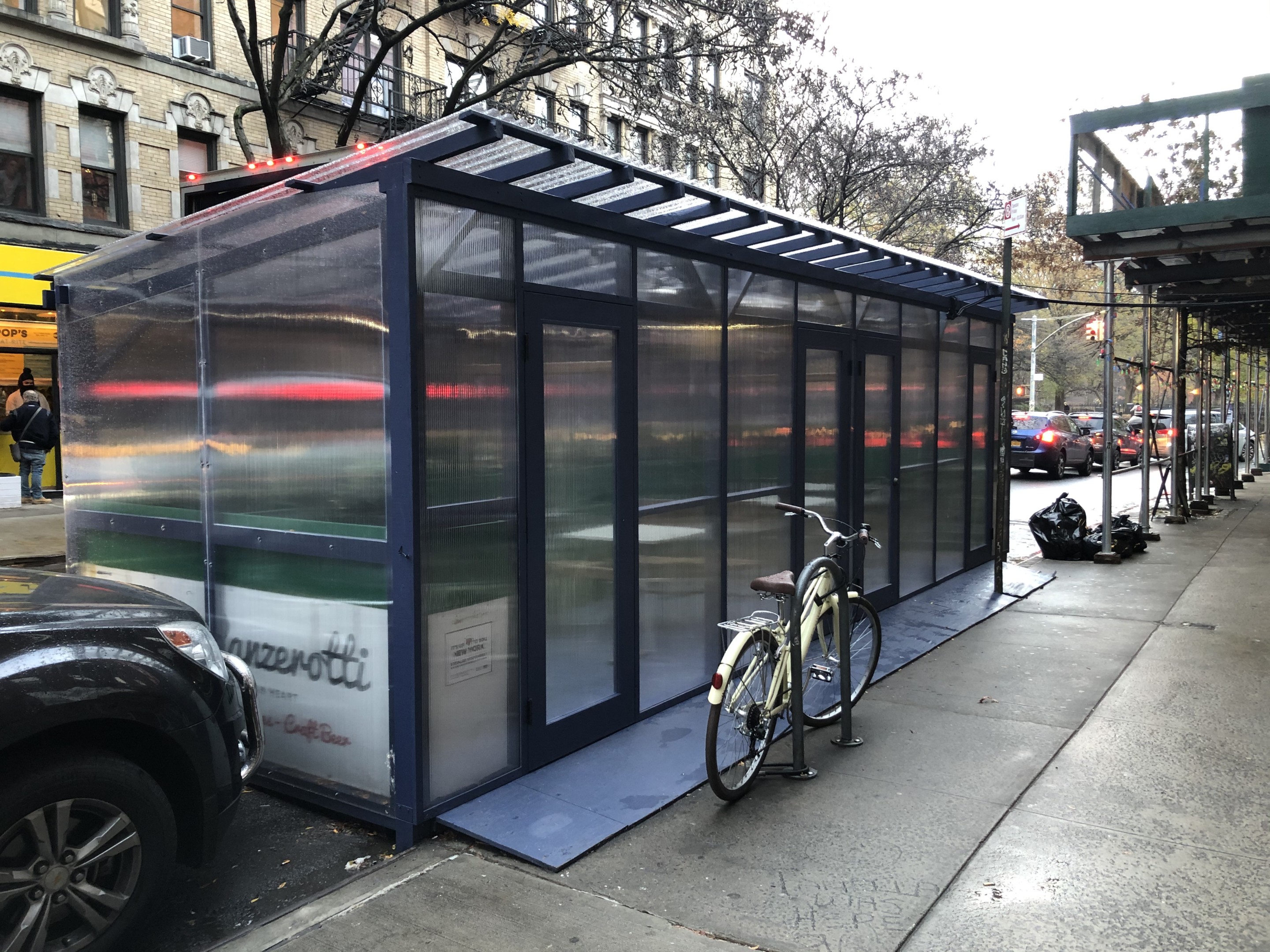
A recent report in the Journal of Korean Medical Science describes a restaurant-based COVID outbreak caused by droplet transmission beyond the standard two-meter social distance. This makes circulation paramount, Kummer said, including 50 percent openings in outdoor structures (two of four structural walls, meaning many existing three- and four-wall dining spaces are out of compliance) and at least four or five air changes per hour. Ceiling fans that draw air upward instead of blowing it down are an affordable measure; another is oblique seating arrangements with six-foot distancing between chair backs (“not from table to table”) and no diners face to face. He was struck by the conclusion of the Korean report, which found that “if you’re next to somebody and they’re not facing you, you’re much safer than if you’re 20 feet away from somebody whose breath is blown straight at you.”
Other measures, Kummer observed, are essentially “security theater,” such as “ridiculous amounts of wiping down tables, when it’s masking and air ventilation that make the difference.” Barriers are common but unreliable or even counterproductive, he believes: “We’re just steering clear of plexiglass barriers because we don’t understand quite who it’s protecting; if they’re done wrong, they trap the virus and keep it still and endanger the server… All of these outdoor igloos and little cabins, like train compartments, I think of them as death traps. They may be fine for one pod of diners who are exposing each other all the time to their own breath and aerosols, but they’re not fine for the next group of diners unless there’s an industrial fan that’s exhausting it between table turns, and they’re definitely not fine for servers.” The guiding principle for any establishment, he said, is “as much distance between tables as you can afford without going broke, and as much fresh-air circulation as you can manage and your diners can stand without turning into human icicles.”
With indoor dining again imperiled, and outdoor structures perhaps becoming the hospitality sector’s only hope, a great deal rides on restaurateurs and diners getting things right, making this new typology a promising refuge rather than a disease incubator. “It only happens every so often that people’s hearts and minds are open to a different way of thinking about streets, and we’re in one of those moments,” WXY’s Vega-Barachowitz said. Turning yesterday’s auto-storage area into today’s four-top has gone surprisingly smoothly; whether it evolves into tomorrow’s green oasis, library kiosk, outdoor gym, or dance space will depend on the nuts and bolts of how we hold both the resurgent pandemic and the weather at bay.









